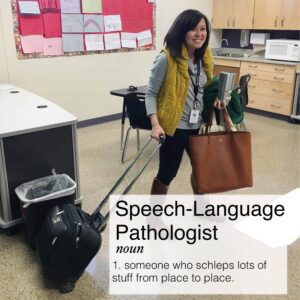It was not until my sophomore year of college that I realized that I needed to go to graduate school to become a speech-language pathologist? What?! Two more years of school? No one told me about this part of the plan.

A few years later, I started working in a school, and I quickly realized my job would include a significant amount of paperwork–writing reports, running Individual Education Plan (IEP) meetings, documenting sessions for Medicaid. Like many others who walked the path before me, I made mistakes, I learned and I got better.
The field of speech-language pathology can surely be mysterious. So, what is speech pathology? As someone who works in a privately own clinic that also supports school districts and Early Childhood Intervention (ECI) groups, I am privy to a diverse SLP life. I work in a clinic, a school and in people’s homes. Today, I want to give you a glimpse of my job as an SLP.
7:15am – I wave good-bye to my husband and 10-month old. Then, my 2 older cherubs and I head to their elementary school. It’s hugs, kisses and, “Have a superb day!”
7:32am-I drive to a daycare.
8:00am – For this part of my day, I am supporting children through ECI, a statewide program for families with children, birth to three, with disabilities and developmental delays. Right now, I see a two-year-old at his daycare. Currently, he uses fewer than 5 words consistently. Last week was his first session, and mom was able to take part in the speechy festivities. By the end of our initial 45-minute session, he was able to put two words together to request for “mo bubu/more bubbles!” Mom was even able to record the accomplishment to show Dad. I was on cloud nine, and I’m thrilled Mom was able to practice the same strategies during the week.
The pros of home-based services? I get to work closely with families. And, that means that parents get to see how to work with their own children. Typically, I give one homework assignment a week that is incorporated into their everyday routine. For example, with this child, I told mom to incorporate the word “more” with a word he already uses (e.g., “more eat,” “more truck”) during mealtime and play time.
9:00am-1:00pm – I head over to the elementary campus I’m currently supporting. I currently see 13 students ranging in age from kindergarten to 5th grade. Some children I see individually, and other children I see in groups of 2-4 students. Today, I start my day by prepping paperwork for an IEP meeting. This particular child is starting speech therapy for the first time, and we need to hold an IEP meeting with parents, teacher and an administrator. I read over the evaluation, and I head over to the child’s classroom to chat with the teacher.
My job as a school-based SLP is to support what’s going on in this child’s first grade classroom. After speaking with the teacher, I draft up goals to address answering wh-questions, drawing conclusions/inferencing and following 2-step directions. Soon enough, I begin my therapy sessions. Personally, I like to incorporate books, books, books into my therapy sessions. Based on experience and research, this is where I get the most bang for my SLP-buck. Here’s a video about 3 rules for a great speech therapy session.
The pros of being a school-based SLP? I support a wide range of needs (e.g., articulation, language, social skills, stuttering) and ages. I also get to support children who may not otherwise receive speech therapy, and I work alongside teachers who have access to the children for 1,260 hours a year. Why is this important? If I collaborate well with the teacher, my students essentially get exposed to continuous speech and language strategies all day long at school.

1:00pm: It’s time for me to head to the clinic to see my clients. One thing I have learned as an itinerant SLP is that I schlep many things around. Over time, I have found creative ways to go from place to place in a (somewhat) efficient manner.
2:00pm: I see a 24-year-old young man who uses a borrowed Dynavox T10 to communicate. Since our time together, he is able to use his communication device to make requests, make comments, greet others, describe and make choices that are meaningful to him. We are currently waiting on approval of his STAP grant to receive a permanent ipad and Dynavox Compass app. I talk to the young man and his mother about his homework. He is use his Dynavox to greet two people in the community. FYI: Mom sent me a video later on in the week demonstrating how her son used his device to ask for a Pepsi.
The pros of working in a clinic? I get to see my clients one-one-one. This is a luxury, and I do not take it for granted. If parents are able to see what I do, then they can do the same thing at home. And, when everyone is on the same page, it’s a win, win, win!
2:45pm: I document my session.
2:53pm: I call the Texas Department of Assistive and Rehabilitative Services (DARS) to check in on another communication device I am trying to obtain for a 23-year-old client.
3:01pm: I see a 2-year-old working on his expressive language. For the first time last week, he put together two words by signing “more” and “book.” Mom was in the session with us, and she was thrilled. At the end of the session, we talk about how to elicit words from the child at home. And, I promised to bring in my stash of Thomas the Train toys for our next session. Remember, it’s important to find out what motivates our students and clients.
3:50pm: I document my session.
4:00pm: It’s time for Friendship League, my social skills group. The group has two 10-year-olds and a 13-year-old. We work on asking questions, making comments, waiting our turn to speak and having fun! The sessions always follow the same format:
1. Snack: It’s the end of the school day and we need to nourish our bodies.
2. Checking In: They each share how their day has been. It’s a good time to honor our current moods and feelings. If a child had a bad day, I make sure to honor his emotional needs.
3. Lesson of the Day: This is where I explicitly teach a lesson. I show the children what a particular social scenario looks like and sounds like.
4. Practice: We practice the skill. Sometimes we act it out. Sometimes we videotape ourselves and watch it.
5. Fly Time: This is time for the children to collectively decide on a “free choice” activity that involves all. We have built towns out of legos, we have drawn and we have danced!
6. Brag: This is time for the children to share a positive observation about a peer. “I want to brag on Suzy for building the lego bridge with me.”
4:52pm: I created a rotating schedule for me to communicate with each of the parents once every month. I sit down with one of the clients and his mother. I share the positives, and we talk about how we can continue to address his communicative needs in a functional way.
5:02pm: I get a brief workout by lugging my stuff to the car. I jump into my mini-van, and I head home to see three more children who happen to contain my genetic make-up. I typically spend my commute completely exhausted and on an SLP-high. My days are not easy, but they are surely meaningful.





It all goes so fast! Before you know it, you will be retired with a wonderful pension from the state of Texas attending the college graduations of your children. It is a wonderful thing to be free during the summer for road trips, trips to museums and parks, library summer reading clubs, and VBS. You might even be lucky enough to love your job so much that you work part time for your district and make more money, pension and 45% combined, than you did your last 3 years as a full time SLP. Its a good life! That’s about 110-115% of your last 3 years salary and I work 17 hours a week. I would highly advise young mothers who don’t have to work full time, to maintain a part time position s with a district and state pension plan during your children’s younger years.
Kristine, thank you for your perspective. Our profession has so much flexibility, and that is a great thing. There are so many avenues we can pursue as SLPs. The best part–we make a difference in all settings. Congratulations on your retirement, and thank you for the time you have given. – Phuong